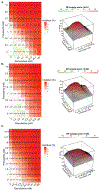Preclinical efficacy of prexasertib in acute lymphoblastic leukemia
- PMID: 34096630
- PMCID: PMC8504167
- DOI: 10.1111/bjh.17610
Preclinical efficacy of prexasertib in acute lymphoblastic leukemia
Abstract
The addition of molecularly targeted therapies to current chemotherapy regimens may improve acute lymphoblastic leukemia (ALL) outcomes and reduce acute and late toxicities. Checkpoint kinase 1 (CHK1) orchestrates cell cycle checkpoint control in the setting of DNA damage. CHK1 is expressed in both T- and B-ALL and represents a promising therapeutic target. Herein, we show that prexasertib, a targeted CHK1 inhibitor, exhibits significant single-agent efficacy in vivo using ALL patient-derived xenograft (PDX) models and synergizes in vitro with a nucleoside analog. These results support further clinical testing of prexasertib in ALL.
Conflict of interest statement
Figures


Similar articles
-
Prexasertib, a Chk1/Chk2 inhibitor, increases the effectiveness of conventional therapy in B-/T- cell progenitor acute lymphoblastic leukemia.Oncotarget. 2016 Aug 16;7(33):53377-53391. doi: 10.18632/oncotarget.10535. Oncotarget. 2016. PMID: 27438145 Free PMC article.
-
Broad Spectrum Activity of the Checkpoint Kinase 1 Inhibitor Prexasertib as a Single Agent or Chemopotentiator Across a Range of Preclinical Pediatric Tumor Models.Clin Cancer Res. 2019 Apr 1;25(7):2278-2289. doi: 10.1158/1078-0432.CCR-18-2728. Epub 2018 Dec 18. Clin Cancer Res. 2019. PMID: 30563935 Free PMC article.
-
Enhanced Efficacy of Combined Therapy with Checkpoint Kinase 1 Inhibitor and Rucaparib via Regulation of Rad51 Expression in BRCA Wild-Type Epithelial Ovarian Cancer Cells.Cancer Res Treat. 2021 Jul;53(3):819-828. doi: 10.4143/crt.2020.1013. Epub 2020 Dec 16. Cancer Res Treat. 2021. PMID: 33332934 Free PMC article.
-
Prexasertib, a checkpoint kinase inhibitor: from preclinical data to clinical development.Cancer Chemother Pharmacol. 2020 Jan;85(1):9-20. doi: 10.1007/s00280-019-03950-y. Epub 2019 Sep 11. Cancer Chemother Pharmacol. 2020. PMID: 31512029 Review.
-
Prexasertib: an investigational checkpoint kinase inhibitor for the treatment of high-grade serous ovarian cancer.Expert Opin Investig Drugs. 2020 Aug;29(8):779-792. doi: 10.1080/13543784.2020.1783238. Epub 2020 Jun 25. Expert Opin Investig Drugs. 2020. PMID: 32539469 Review.
References
-
- Angius G, Tomao S, Stati V, Vici P, Bianco V, Tomao F. Prexasertib, a checkpoint kinase inhibitor: from preclinical data to clinical development. Cancer Chemother Pharmacol. 2020;85(1):9–20. - PubMed
-
- Neizer-Ashun F, Bhattacharya R. Reality CHEK: Understanding the biology and clinical potential of CHK1. Cancer Lett. 2021. January 28;497:202–11. - PubMed
-
- Lowery CD, Dowless M, Renschler M, Blosser W, VanWye AB, Stephens JR, et al. Broad spectrum activity of the checkpoint kinase 1 inhibitor prexasertib as a single agent or chemopotentiator across a range of preclinical pediatric tumor models. Clin Cancer Res. 2019. April 1;25(7):2278–89. - PMC - PubMed
Publication types
MeSH terms
Substances
Grants and funding
LinkOut - more resources
Full Text Sources
Miscellaneous

